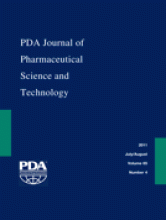Abstract
During storage of recombinant human parathyroid hormone (rhPTH) (amino acid residues 1–34) at 25 ± 2 °C, several impurities were obtained, which were detected by the tricine sodium dodecyl sulfate polyacrylamide gel electrophoresis (SDS-PAGE) and reversed-phase high-performance liquid chromatography (RP-HPLC) methods. To characterize the impurities generated, forceful chemical oxidation and deamidation was done. The oxidized positions were characterized by cyanogen bromide (CNBr) cleavage followed by liquid chromatography/mass spectrometry (LCMS) and further confirmed through N-terminal sequencing. Three oxidized variants were observed: sulfoxide of Met8 and Met18 and a variant comprising sulfoxide forms of both the methionine residues. LCMS results confirmed the presence of deamidated (+1 Da) and succinimide (−17 Da) variants. The low molecular weight impurities observed by tricine SDS-PAGE was confirmed to be peptide fragments by N-terminal sequencing and LCMS, resulting from cleavage at the C-terminal of asparagine (Asn)16, Asn33, and Asp30. Studies showed that rhPTH (1–34) undergoes oxidation, deamidation, and peptide bond cleavage during storage at pH 4.0 in acetate buffer.
LAY ABSTRACT: Unlike currently licensed therapies to manage osteoporosis, parathyroid hormone (PTH) and its analogs represent a new class of anabolic agents, which act primarily to inhibit bone resorption and remodeling. The hormone's recombinant form is a bioactive peptide, 1–34 residues, which is inherently very unstable. Prior understanding of the molecular degradation pathway will help in development of a process that will yield a better product with respect to its quality and stability. The current work focuses on detailed characterization of the product-related impurities generated during storage of recombinant human PTH. The study depicted the various routes through which the molecule can degrade during its shelf life. Through a combination of forced degradation and accelerated study, it was established that the impurities were generated owing to oxidation, deamidation, and peptide bond cleavage of/at various amino acid residues.
Until this study, it was presumed that oxidation is the primary route of degradation in PTH and most of the published reports were on native (1–84) forms of the hormone. The present research confirms that the recombinant hormone (1–34) degraded not only because of oxidation but that deamidation and peptide bond cleavage are also prominent modes of degradation. Therefore, owing to the unstable nature of the molecule it is suggested that stringent conditions should be maintained during manufacturing to obtain a stable molecule with fewer impurities.
- © PDA, Inc. 2011
PDA members receive access to all articles published in the current year and previous volume year. Institutional subscribers received access to all content. Log in below to receive access to this article if you are either of these.
If you are neither or you are a PDA member trying to access an article outside of your membership license, then you must purchase access to this article (below). If you do not have a username or password for JPST, you will be required to create an account prior to purchasing.
Full issue PDFs are for PDA members only.
Note to pda.org users
The PDA and PDA bookstore websites (www.pda.org and www.pda.org/bookstore) are separate websites from the PDA JPST website. When you first join PDA, your initial UserID and Password are sent to HighWirePress to create your PDA JPST account. Subsequent UserrID and Password changes required at the PDA websites will not pass on to PDA JPST and vice versa. If you forget your PDA JPST UserID and/or Password, you can request help to retrieve UserID and reset Password below.






